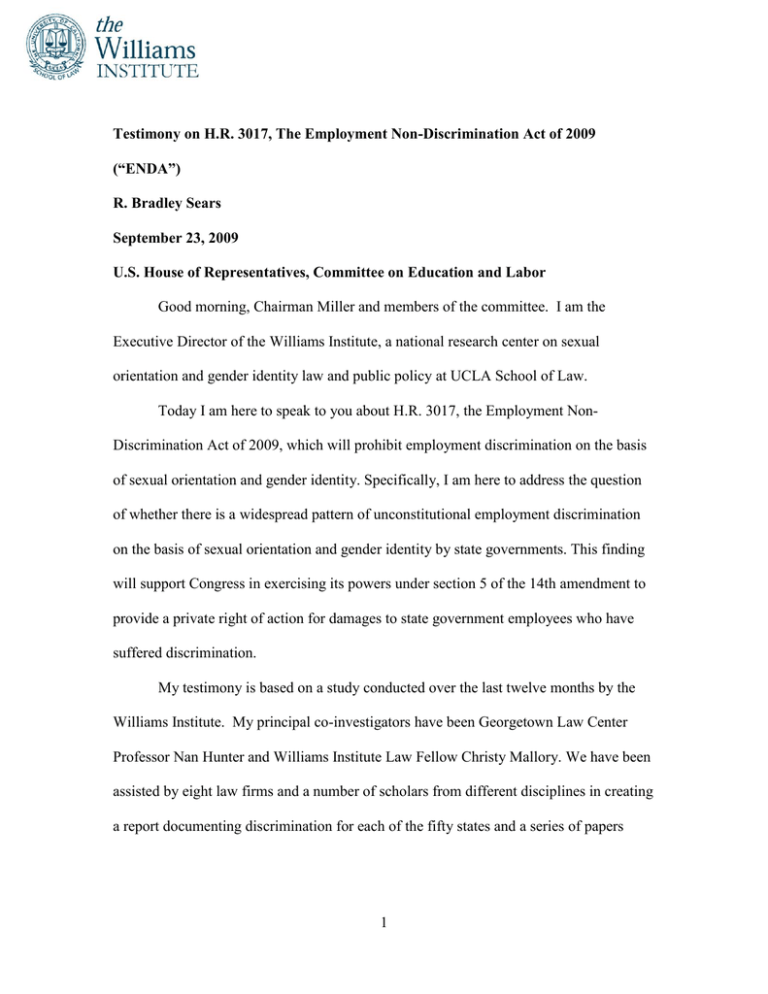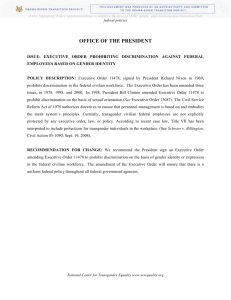
Testimony on H.R. 3017, The Employment Non-Discrimination Act of 2009
(“ENDA”)
R. Bradley Sears
September 23, 2009
U.S. House of Representatives, Committee on Education and Labor
Good morning, Chairman Miller and members of the committee. I am the
Executive Director of the Williams Institute, a national research center on sexual
orientation and gender identity law and public policy at UCLA School of Law.
Today I am here to speak to you about H.R. 3017, the Employment NonDiscrimination Act of 2009, which will prohibit employment discrimination on the basis
of sexual orientation and gender identity. Specifically, I am here to address the question
of whether there is a widespread pattern of unconstitutional employment discrimination
on the basis of sexual orientation and gender identity by state governments. This finding
will support Congress in exercising its powers under section 5 of the 14th amendment to
provide a private right of action for damages to state government employees who have
suffered discrimination.
My testimony is based on a study conducted over the last twelve months by the
Williams Institute. My principal co-investigators have been Georgetown Law Center
Professor Nan Hunter and Williams Institute Law Fellow Christy Mallory. We have been
assisted by eight law firms and a number of scholars from different disciplines in creating
a report documenting discrimination for each of the fifty states and a series of papers
1
summarizing our findings. The full text of the completed study will be posted on the
Williams Institute web site http://www.law.ucla.edu/williamsinstitute/home.html.
Based on this research, we conclude that there has been a widespread and
persistent pattern of unconstitutional discrimination by state governments. Although
additional types of evidence support our findings and are discussed in the report, I am
going to focus on four key sources today.
First, we reviewed surveys of LGBT people about their experiences of
discrimination. We identified over eighty surveys in which either all or some of the
respondents were public sector employees. All of these surveys found that significant
percentages of LGBT public employees reported being fired, denied jobs, denied
promotions, or harassed in the workplace. For example, one in five LGB public sector
employees in the 2008 General Social Survey reported being discriminated against on the
basis of their sexual orientation, and a survey this year of over 640 transgender
employees (in both public and private sectors) found that 70% reported experiencing
workplace discrimination on the basis of gender identity. Another 2009 survey of more
than 1,900 LGBT employees of state university systems nationwide found that more than
13% had experienced discriminatory treatment or harassment during the past year alone.
When we compare this set of studies to prior reviews that the Williams Institute
has conducted of employment discrimination surveys, we find no difference between the
patterns of employment discrimination against LGBT people in the public sector and in
the private sector, and no difference in the patterns of such discrimination against LGBT
workers in state versus local government agencies.
2
Second, we collected data about complaints from state and local administrative
agencies charged with enforcing prohibitions against sexual orientation and gender
identity discrimination. Although we requested data from twenty state and 203 local
agencies, many did not respond, even after repeated requests. The agencies that did
respond provided us with 430 administrative complaints of sexual orientation and gender
identity discrimination by state and local employers between 1999 and 2007. Although
not all states could provide us with data distinguishing between state and local
government defendants, at least 265 of these were filed by employees of state
government agencies.
Additional evidence suggests that many of these complaints of discrimination are
well-founded. Five states provided us information about the dispositions of the claims
made by state employees.
For four of these states, the combined rate of positive
administrative outcomes for the complaints, such as findings of probable cause of
discrimination or settlements, averaged 30%. For the fifth state, California, 61% of
complainants sought an immediate right to sue letter, which often indicates they have
already found counsel to take their cases to court. A review of the dispositions of
complaints made to local enforcement agencies found a similar rate of favorable
outcomes.
Third, we reviewed studies surveying the differences in wages between LGB
employees and their heterosexual counterparts. If, after controlling for factors significant
for determining wages such as education, a wage gap exists between people who have
different personal characteristics, such as sexual orientation, economists typically
conclude that the most likely reason for the wage gap is discrimination. More than
3
twelve studies have shown a significant wage gap, ranging from 10% to 32%, for gay
men when compared to heterosexual men. Two recent studies have found similar wage
gaps when looking just at public employees. Together, the studies find that gay men,
lesbians, and bisexuals who are government employees earn 8% to 29% less than their
heterosexual counterparts. Men in same-sex couples who are state employees earn 8% to
10% less than their married heterosexual counterparts. These studies, too, suggest that
sexual orientation discrimination in state government is similar to that in the private
sector and other public employment.
Fourth, we compiled a set of documented examples of discrimination based on
sexual orientation and gender identity that further supports a finding of a widespread and
continuing pattern of unconstitutional discrimination by state and local governments. We
collected examples from court opinions, administrative complaints, academic journals,
books, newspapers, and community-based organizations. We placed time limits on the
study in order to test whether such discrimination is persistent. In total, we have compiled
more than 380 specific examples of workplace discrimination, almost all occurring within
the last 20 years.
This record demonstrates that discrimination is widespread in terms of quantity,
geography, and occupations. The quantity compares favorably to that of past records of
public employment discrimination supporting civil rights legislation. Geographically, the
examples reach into every state except North Dakota, which has a smaller population.
The LGBT employees discriminated against work for every branch of state government:
legislatures, judiciaries, and the executive branch. The examples include public
employees who help people find jobs, housing, and health care; teachers and professors;
4
state troopers and prison guards; judges, bus drivers and tax collectors; and those who
work for museums and for the DMV.
In many of these cases, courts have found violations of rights to equal protection,
free expression, and privacy, as well as the impermissible use of sex stereotypes. There
are also cases where plaintiffs lose, because judges rule that, in the absence a law like
ENDA, state and federal law do not provide a remedy.
What is missing in all of these cases is any rational reason for the adverse
employment action, whether or not the law provides a remedy. In none of these cases do
employers assert that sexual orientation or gender identity impacts an employee’s
performance in the workplace. To the contrary, among the examples of public servants
who have been discriminated against are a gay faculty member at Louisiana State
University who had received a Distinguished Service Award; a transgender sheriff in
Oregon who had received a commendation for delivering a baby on the side of a
highway, and a lesbian social worker in Mississippi who was told she was one of the best
employees at her center helping mentally disabled children.
The irrationality of the discrimination is also vividly indicated by the harassment
that many of these workers have been subjected to. With my apologies, here is a very
limited sense of what they are called in the workplace: an officer at a state correctional
facility in New York, “pervert” and “homo;” a lab technician at a state hospital in
Washington, a “dyke;” an employee of New Mexico’s Juvenile Justice System, a
“queer.” The language that you can read in the report gets worse from there. What is
also striking about these examples of workplace harassment is the degree to which the
words are accompanied with physical violence. A gay employee of the Connecticut State
5
Maintenance Department was tied up by his hands and feet; a firefighter in California had
urine put in her mouthwash; a transgender corrections officer in New Hampshire was
slammed into a concrete wall; and a transgender librarian at a college in Oklahoma had a
flyer circulated about her that said God wanted her to die. When employees complain
about this kind of harassment, they are often told that it is of their own making, and no
action is taken.
These 380-plus documented examples should in no way be taken as a complete
record of discrimination against LGBT people by state and local governments. Based on
our research, and on other scholarship, we have concluded that these examples represent
just a fraction of the actual discrimination. First, our record does not even completely
capture all of the documented instances. For example, of the twenty state enforcement
agencies we contacted, only six made available redacted complaints for us to review.
Second, several academic studies have shown that state and local administrative agencies
often lack the resources, knowledge and willingness to consider sexual orientation and
gender identity discrimination complaints. Similarly, legal scholars have noted that
courts and judges have often been unreceptive to LGBT plaintiffs and reluctant to write
published opinions about them, reducing the number of court opinions and administrative
complaints that we would expect to find.
Third, many cases settle before an
administrative complaint or court case is filed. Unless the parties want the settlement to
be public, and the settlement is for a large amount, it is likely to go unreported in the
media or academic journals. Fourth, LGBT employees are often reluctant to pursue
claims for fear of retaliation or of outing themselves further in their workplace. For
example, in a study published this month by the Transgender Law Center, only 15% of
6
those who reported that they had experienced some form of discrimination had filed a
complaint. Finally, and perhaps most important, numerous studies have documented that
as many one-third of LGBT people are not out in the workplace. They try to avoid
discrimination by hiding who they are.
In our study, we also considered other forms of evidence of employment
discrimination besides these, including similar findings reached by courts and legal
scholars; findings of such discrimination by government officials and commissions; the
long history of state laws, polices, and practices explicitly discriminating against LGBT
employees, and more recent statements showing animus against LGBT people by state
and local government officials.
Based on this research as well as the research I have just discussed, we conclude
that:
1) there is a widespread and persistent pattern of unconstitutional discrimination
against LGBT state government employees, as well as against local government
employees;
2) there is no meaningful difference in the pattern and scope of employment
discrimination against LGBT people by state governments compared to what is found in
the private sector or in federal or local government; and
3) that the list of documented examples that we have compiled far underrepresents the actual prevalence of employment discrimination against LGBT people by
state and local governments.
Thank you.
7




